Who is Nestory Irankunda?
Some people seem to be destined for greatness, but Nestory Irankunda definitely was not one of them.
Born in a refugee camp in Tanzania after his parents had to flee Burundi due to civil war, the young boy’s future was in doubt from the start.
His parents then moved to Australia, where he grew up along with his seven siblings in Adelaide.
Irankunda’s career started to take off in 2021 when he was brought in for a trial by Adelaide United.
From then on, he took off, signing a professional contract in September of 2021 and making his A-League debut in January of 2022 at just 15 years of age, scoring his first goal just a couple of weeks after his debut.
Overall, Irankunda managed to make 60 appearances for Adelaide United, scoring 16 goals in that span.
After good performances in the A-League, Irankunda was invited to the U-17 national team and even made his senior international debut in June of 2024.
After being such an accomplished player at the age of just 18 years, many teams tried to get their hands on Irankunda.
Ultimately, he decided to join FC Bayern München in the German Bundesliga.
The decision was heavily influenced by his father’s sympathy for the club; many Premier League teams were also interested.
In this Nestory Irankunda scout report, we will examine Irankunda’s playing style in and out of possession, his strengths, and where he still needs to improve to take the next step in European football over the coming years.
Nestory Irankunda Style Of Play & Position
Nestory Irankunda has a very interesting data profile for multiple reasons.
His offensive Output is highly respectable for a winger, especially for a player his age.
With 0.28 xG/90 and 0.25 xA/90, Irankunda created a good amount of chances and goal-scoring opportunities for his team during the season.
Suppose we are looking at the xG-side of things.
In that case, Irankunda is not generating this much-expected goals by bringing himself in amazing scoring positions, but rather by the volume of his finishing.
His 3.68 shots per 90 minutes rank fifth compared to other wingers in the A-League.
This means his average xG per shot stands at 0.076, which is not bad but not great either.
This just shows that Irankunda is not shying away from pulling the trigger and has been letting it fly throughout the last season, but that is not a bad thing per se.
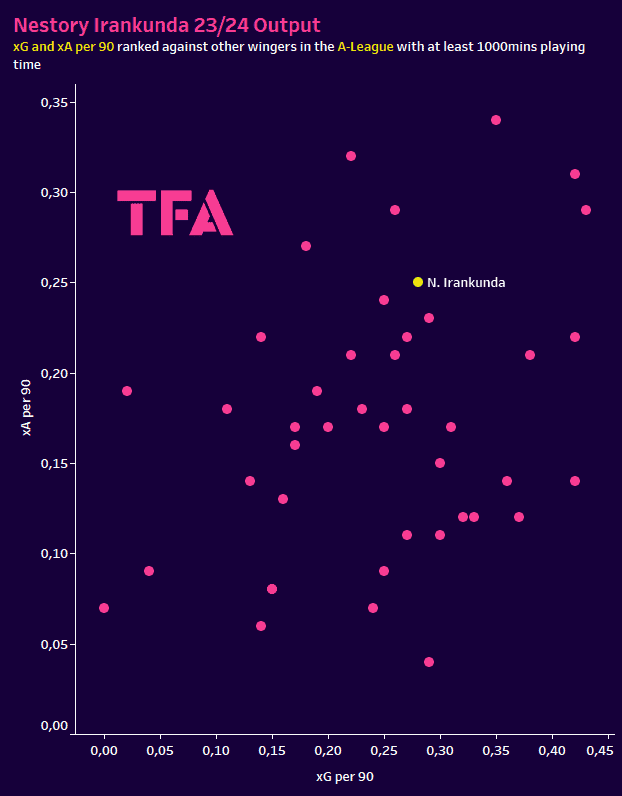
Irankunda’s ability to finish off attacks for Adelaide United has been crucial for them to create scoring chances and not lose balls in the attacking phase most of the time.
His xA/90 Output is also decent, ranking 9th in the league. It’s rather interesting that Irankunda’s xA/90 is also that high for two reasons.
Firstly, usually, players like Irankunda, who are focusing a lot on their shot creation, are not creating a ton of chances for their teammates, but Irankunda does.
Secondly, the majority of wingers with a high xA-value are really reliant on crossing. Irankunda’s 3.14 crosses per 90 are rather average, and his success rate on crosses, with 20.31%, is in the bottom three of A-League wingers.
Overall, another positive thing is his overperformance in those metrics. Irankunda managed eight goals and 6 assists out of 5.61 xG and 5.15 xA.
That just shows his above-average ability in the final third and in creating opportunities for himself and his teammates.
Another very noticeable thing when looking at Irankunda’s stats are his dribbling stats.
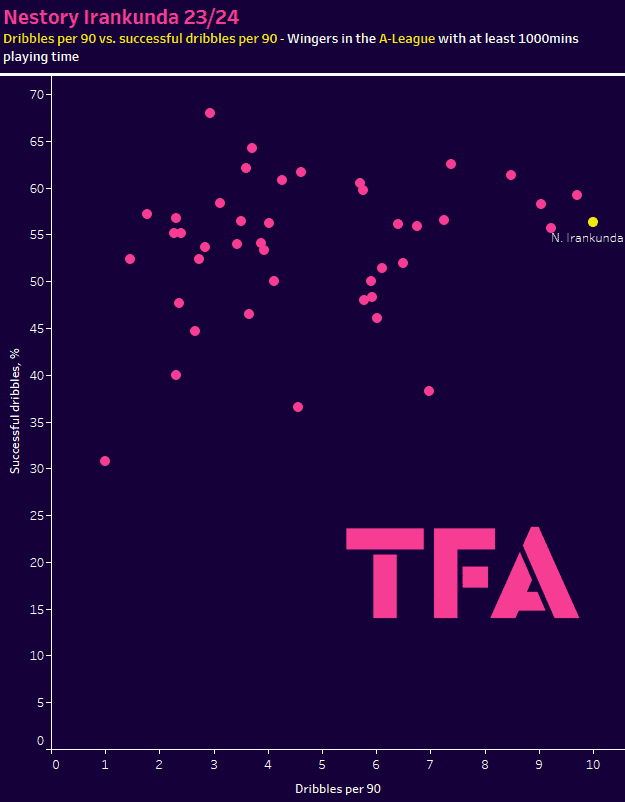
Among the qualifying wingers in the A-League, Irankunda attempts the most dribbles per 90 minutes with 10.
Irankunda obviously is very keen on taking on his defenders and trying to get past them quickly.
Another factor in his dribbling is his pace. Irankunda has reached speeds of over 37km/h during his time in Australia, so using his natural athletic ability by trying to dribble past opponents just makes a lot of sense.
Still, he needs to be more efficient with his dribbles. His percentage of % successful dribblings with 56.37%, ranks only 17th amongst qualifying players.
While it is still above average, and it’s impressive that he can sustain a positive percentage of successful dribblings while having this high of a volume of dribblings, Irankunda still loses a lot of balls this way and needs to improve his decision making there a bit.
If we dig deeper into the data to learn more about Nestory Irankunda’s playing style, something immediately catches our eye.
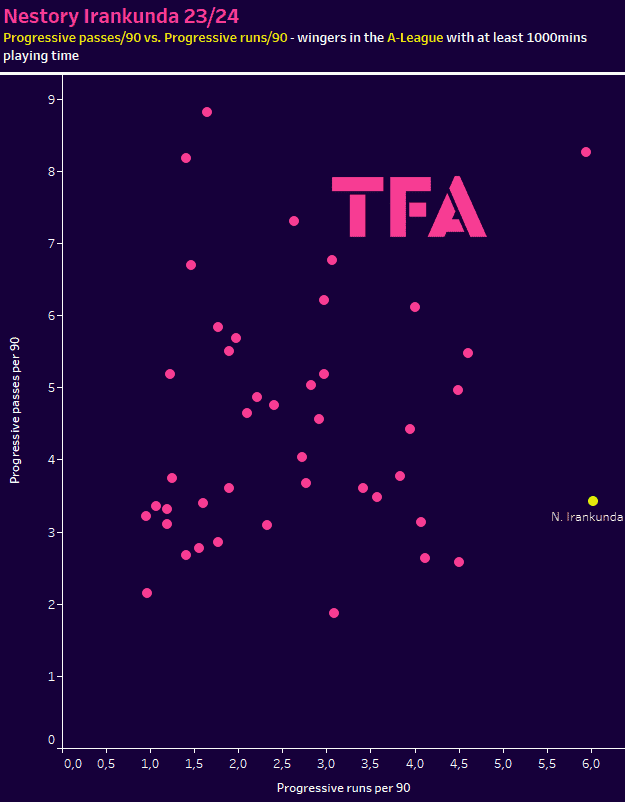
Looking at the ways that qualifying wingers are progressing the ball in the A-League, Irankunda is a standout—his 6.03 progressive runs per 90 minutes rank him number 1 of qualifying players.
Irankunda is elite at carrying the ball forward and finding space to dribble into after receiving the ball.
This makes Adelaide United’s attacking game very dynamic and forces a lot of action all around the pitch.
Irankunda is great at pushing the ball upfield and abusing the high defensive line of opponents.
On the other hand, Irankunda’s 3.43 progressive passes only rank 30th amongst the qualifying players.
Most of these progressive passes are in the final third, which is obviously great for goal and shot creation but shows one significant weakness of Irankunda: His passing ability is lacking in the build-up and transitional play.
He is over-reliant on his dribbling to advance the ball into the opposing half and the final third.
Especially under pressure, Irankunda struggles to find solutions to pass the ball. Especially at FC Bayern, he needs to improve if he wants to have a shot on the first team.
Overall, Irankunda has a very intriguing scouting profile for a young winger in a relatively weak competition, but there have been multiple areas for improvement shown in the data.
Nestory Irankunda In Possession
In possession, Irankunda is a rather traditional winger. He usually plays on the right, and he interprets his position very well and provides a lot of width for his team in the attacking phase of the game.
Irankunda tries to receive the ball in a half-open stance near the sideline. From there on, he moves inwards rather quickly.
Irankunda isn’t integrated a lot in his team’s passing or build-up; he rather tries to pull defenders outwards so his side’s effective playing space is big enough to progress the ball into the final third.
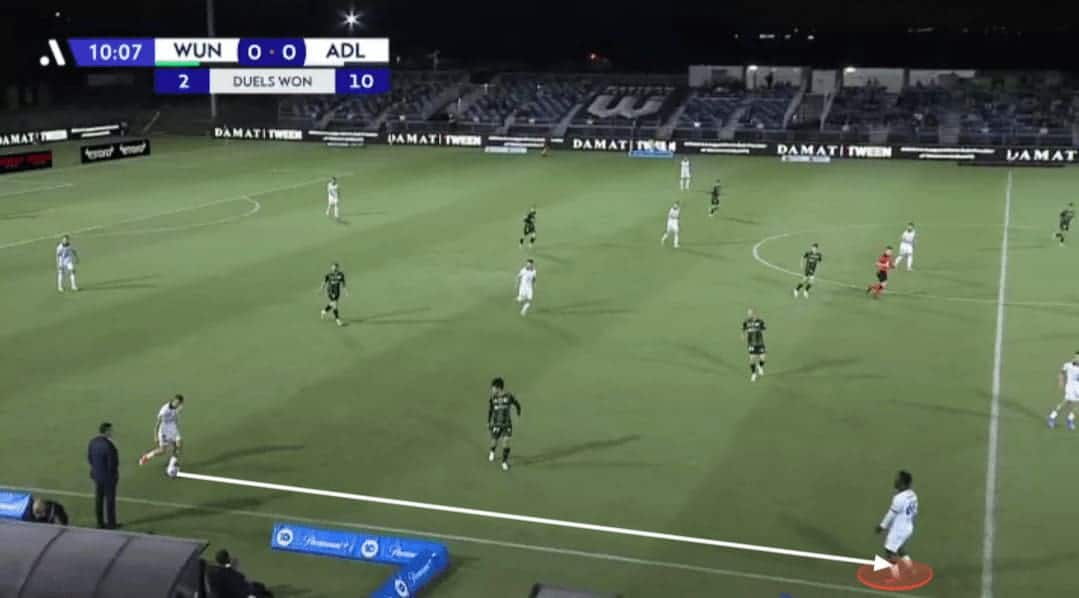
Irankunda likes to pick up the pace after receiving the ball, carrying it towards the goal most of the time. He does not receive many balls behind the defensive line and is more active in deeper zones. He also likes playing with a third man to get a deep run behind the defence.
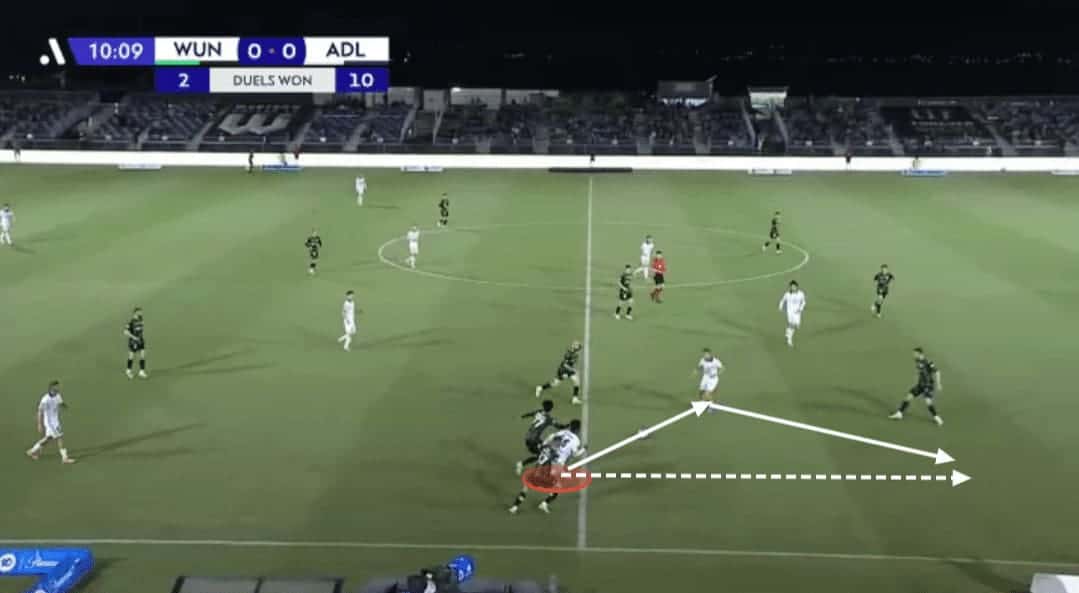
After receiving the ball, Irankunda is rarely wasting time. Most of the time, he turns toward the goal with his first touch and dribbles the ball toward the opposing defensive line.
With his nice acceleration as well as his fearless style of play, he is a handful to defend for most defences in the A-League.
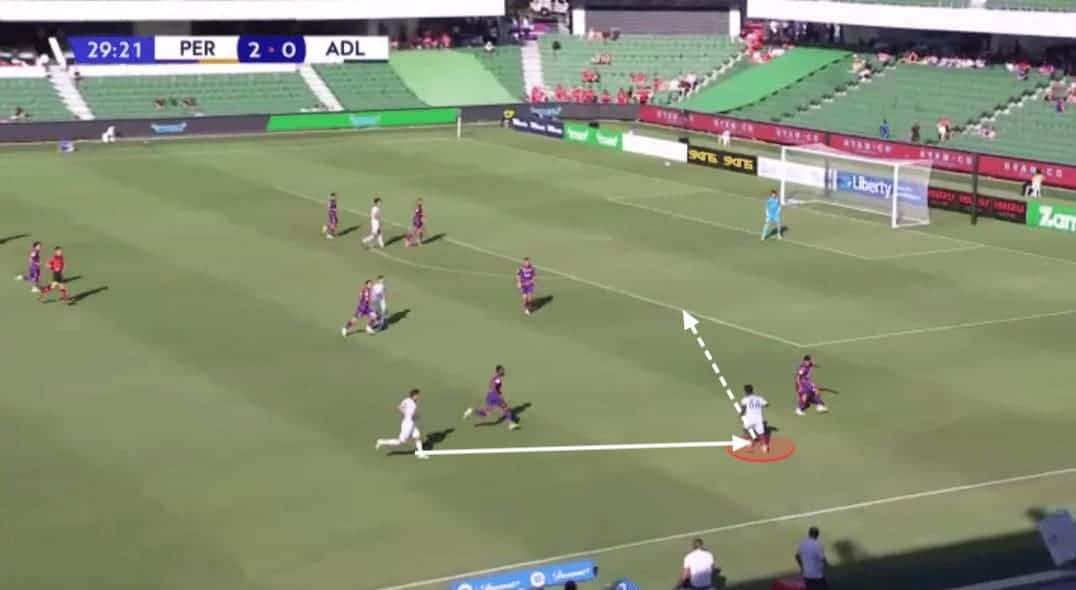
With his pace, he is a constant threat in transitional play and is helping his team advance from build-up play to attacking play most of the time.
Irankunda is not dribbling out wide; however, he drifts inwards most of the time.
This leads to reactions of the opposing defence because he is a huge threat out of more central positions because of his excellent shooting technique. Irankunda is dribbling onto a defender, pulling him out of position a lot.
After pulling the defender out of position, Irankunda is a big fan of attacking the space behind the defensive line.
He plays a lot of passes into the spaces he opened up with his dribbling and is confident in his ability to complete these passes as well.
Irankunda uses his dribbling and agility very well, not just forcing his assigned defenders to gravitate towards him but also opening up passing windows and passing angles to progress the ball out of his low stance in an instant.
While Irankunda is great at attacking the holes in an opposing defence and carrying the ball into the final third, he lacks quality in his passing ability.
His passes are not placed the right way most of the time and are hard to control for his teammates. Another problem is the pressure on his passes.
He just puts too much power onto them a lot of the time, which makes his through balls hard to reach for his teammates.
His range in passing the ball is also somewhat limited. Irankunda rarely plays switches, and if he does, the balls are under-hit most of the time.
While he has an impressive vision even when dribbling and realises the option of switching pretty often, the execution mostly lacks finesse.
As already pointed out in the data profile, Irankunda is not someone who can progress in play through his passing ability.
He is an elite ball carrier, but he will definitely need to improve to be a bigger part of his team’s combinations if we want to succeed at FC Bayern München.
Nestory Irankunda Against The Ball
In a recent interview with FC Bayern, Irankunda told a story about how he always wanted to play as a centre-back when he was younger.
With his height and skill set, he had no future in the position, but some of the traits he developed there are still visible in his game today.
Irankunda shows a lot of motor in tracking back against the ball.
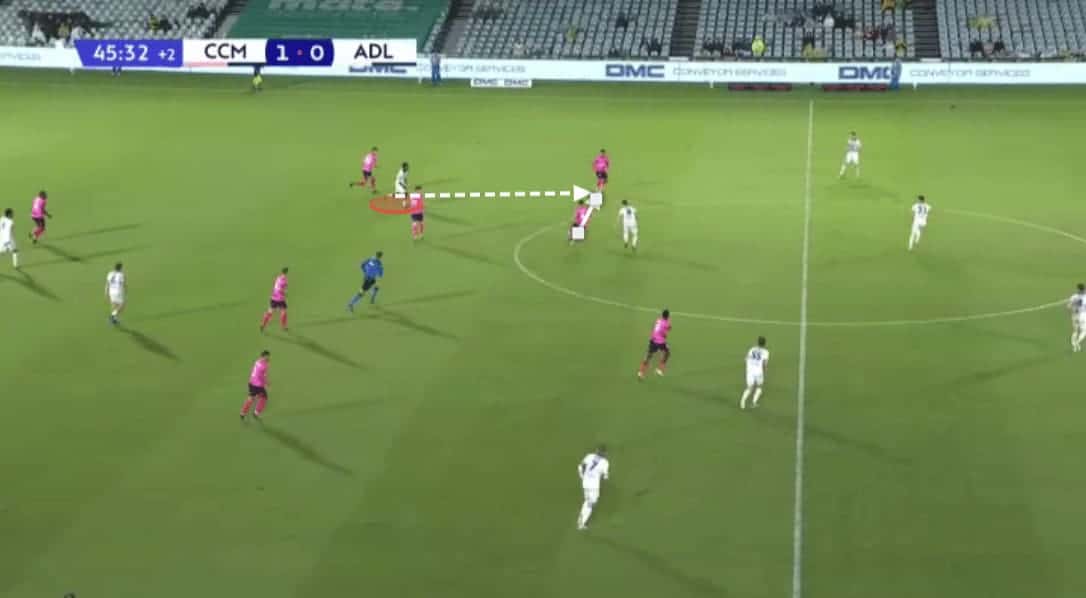
Here you can see the opposing team trying to advance the ball after playing through the pressing of Adelaide.
Irankunda uses his pace to track back and put some pressure on the ball. Irankunda ends up fouling in this situation, but he still manages to interrupt the counterattack.
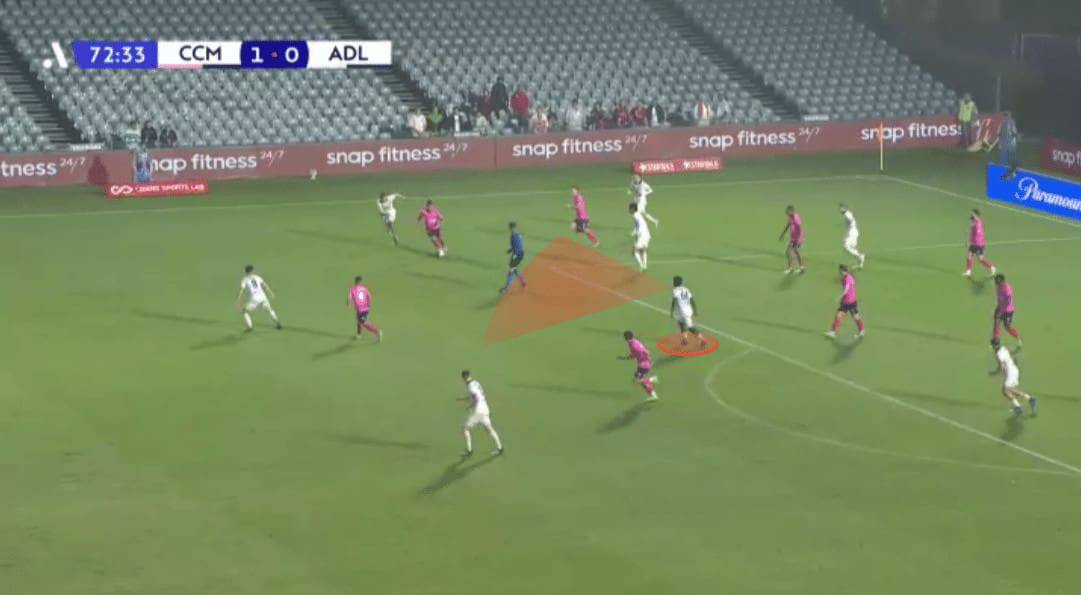
Here, Irankunda scans the field after his team loses the ball and realises that the opponent only has one chance, dribbling the ball towards the centre.
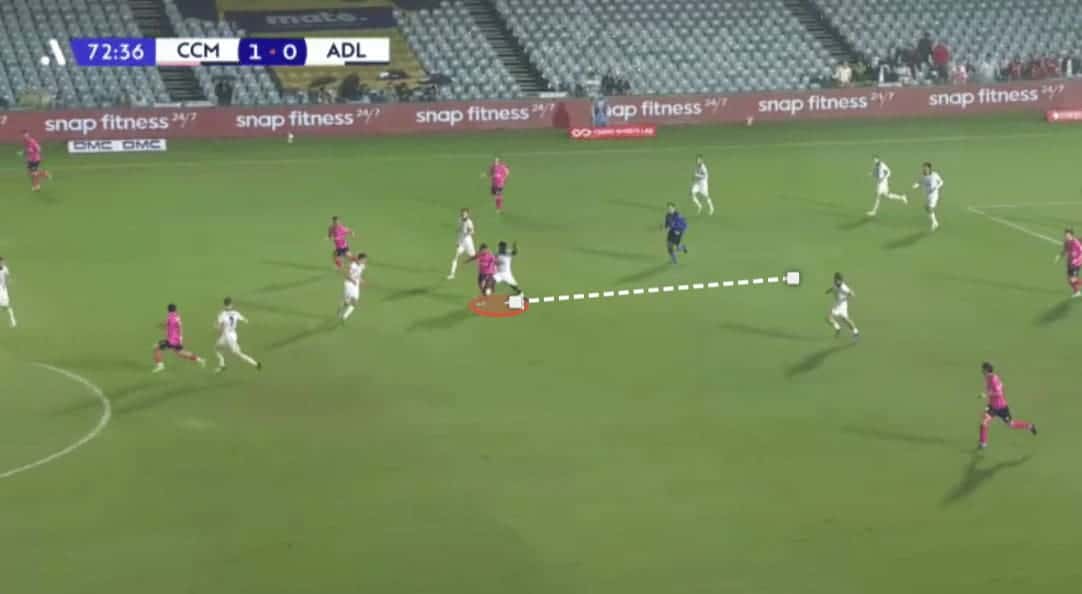
Irankunda uses his pace to recover after losing the ball and forces a tackle in the middle of the field. He doesn’t just show a great understanding of the defensive side of the game here; he also timed his tackling absolutely perfectly, something he learned in the past as a centre-back.
While his past as a defender in these situations is visible most of the time, there still are some issues.
While he plays with a high intensity and uses his body well, this ends up in a lot of unnecessary fouls as well, as shown in the first example.
Irankunda holds his wide position when pressing and scans the field very well.
However, he is not overly man-oriented in the press; Adelaide United uses more zone coverage while pressing upfront. Irankunda shows great patience in these situations.
He doesn’t press forward a lot and prioritises a compact defensive formation.
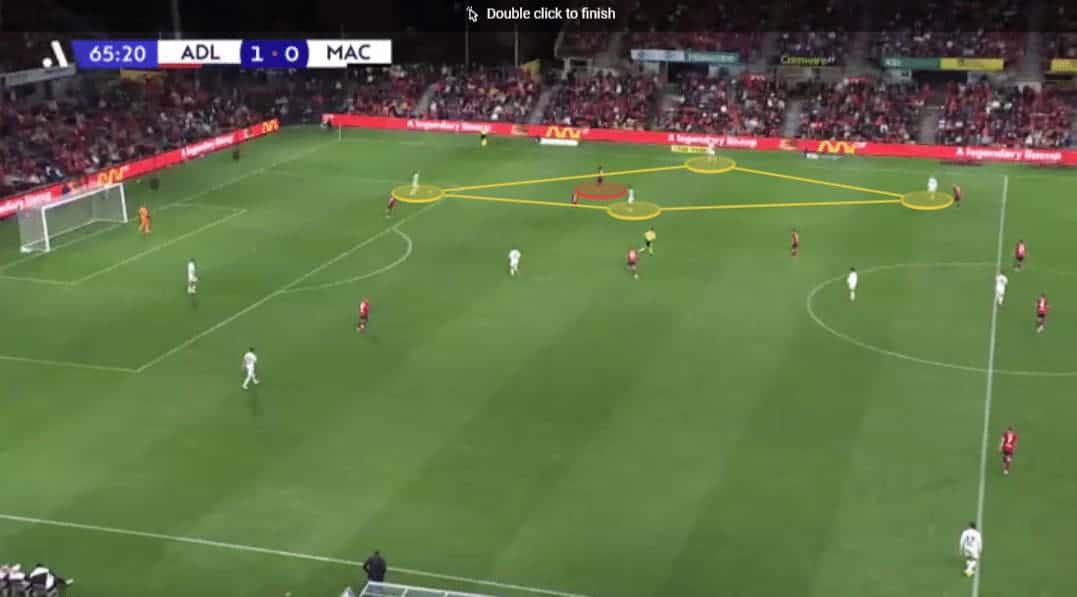
Here, Irankunda is in a pretty bad situation, being caught in a diamond shape the opponent uses in the build-up. He does not press forward here but stays patient and cuts off passing options for the centre-back.
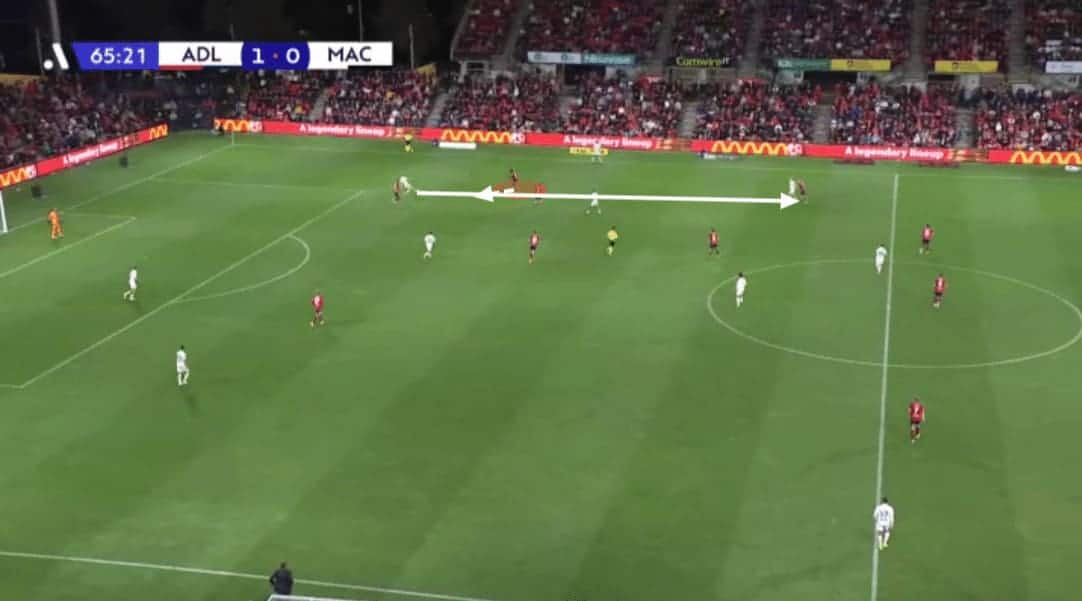
Irankunda baits the centre-back into playing the high-risk pass upfield and then gambles on the interception.
In this case, it worked out very well for him, forcing a high recovery for his team.
This is a boom-or-bust playstyle, however, because if he misses out on the interception there, Adelaide’s press is broken up, and his defenders are left exposed.
While Nestory Irankunda has shown flashes of potential on the defensive side, especially because of his past as a defender, he still needs to work out the details on this side of the ball.
Nestory Irankunda Transitional play
After losing the ball, Irankunda is a menace in the counter-press.
He is consistently ready to engage in pressure and is always oriented forward after losing the ball.
He is always on the tip of his feet, always ready to sprint and chase the ball.
He is not afraid to take risks and shows great trust in his teammates defending the space he leaves open behind him.
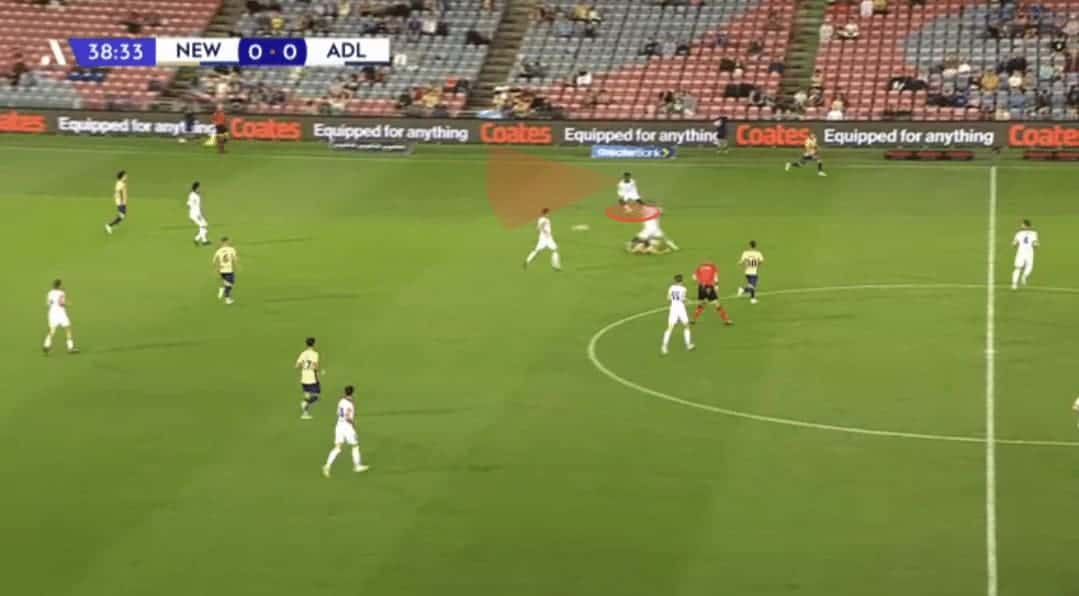
In this example, Adelaide United loses the ball quickly after winning it. Irankunda instantly orients forward, only having eyes for the ball and looking forward the entire time.
He is in a sprinter stance instantly and engages in the counterpress within an instant.
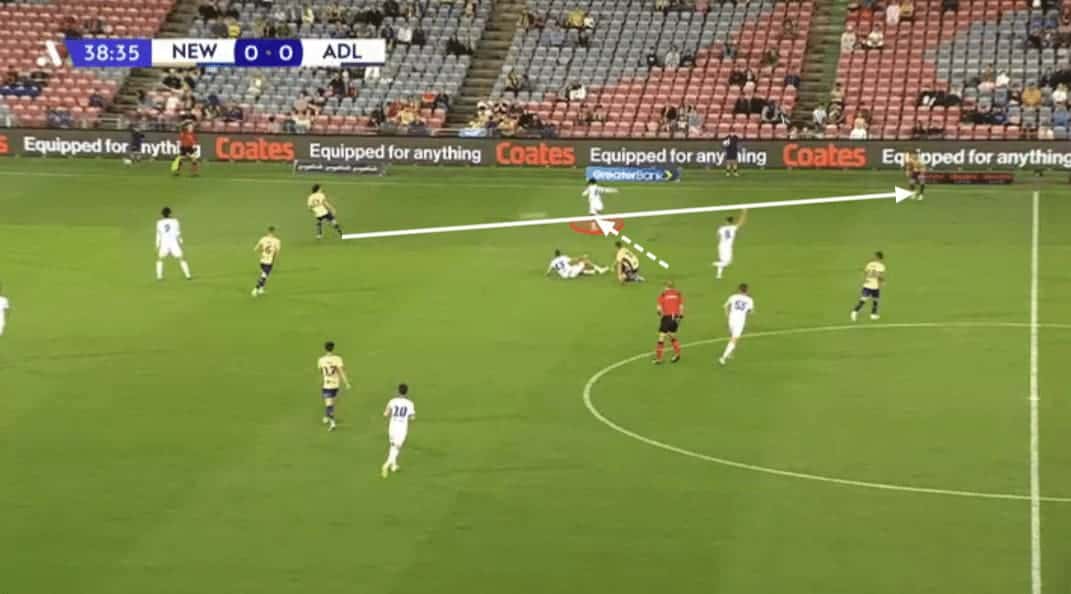
Irankunda realises he can‘t just reach the ball in this situation and cuts off the only possible passing option for the opposing player.
He sprints into the passing lane and manages to block the pass, winning the ball back for Adelaide United and preventing the counterattack. This shows Irankunda’s proficiency in counterpressing.
After winning the ball, Irankunda is a threat as well. As previously stated in this scout report, Irankunda is always trying to progress the ball through the means of carries and dribbling.
In transition, this is just another huge strength that he possesses. The moment he receives the ball on the counter, he presses down the gas pedal and picks up the pace.
However, he is not the target player Adelaide United is looking for with the first pass on the counter.
Usually, Irankunda is on the far side of the pitch and holds a very wide position in transition.
His teammates overload the left side and play some quick combinations, and then they try to release Irankunda in space on the right side with a switch.
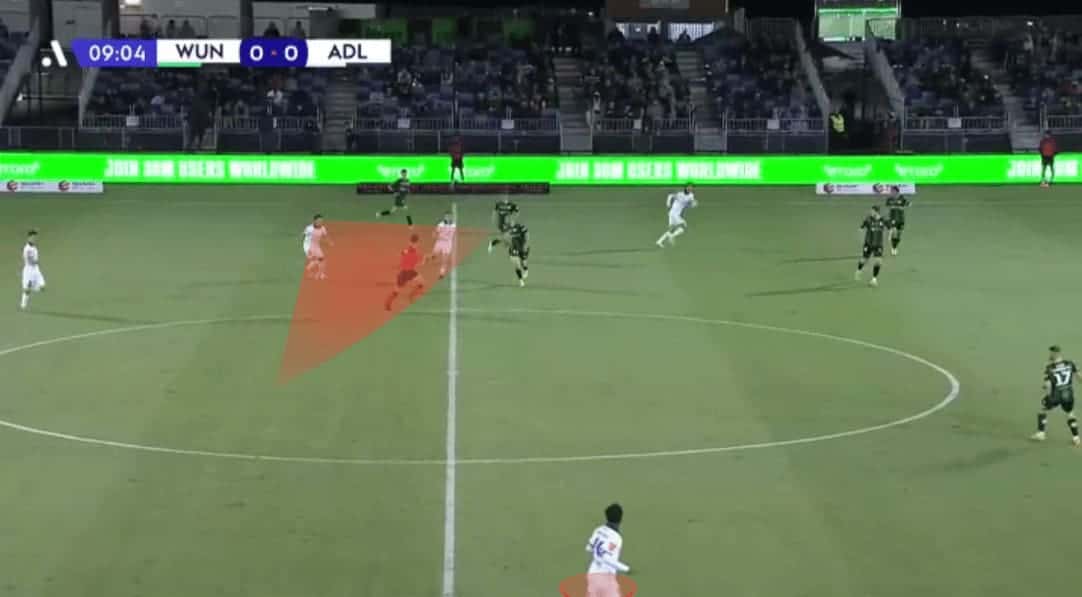
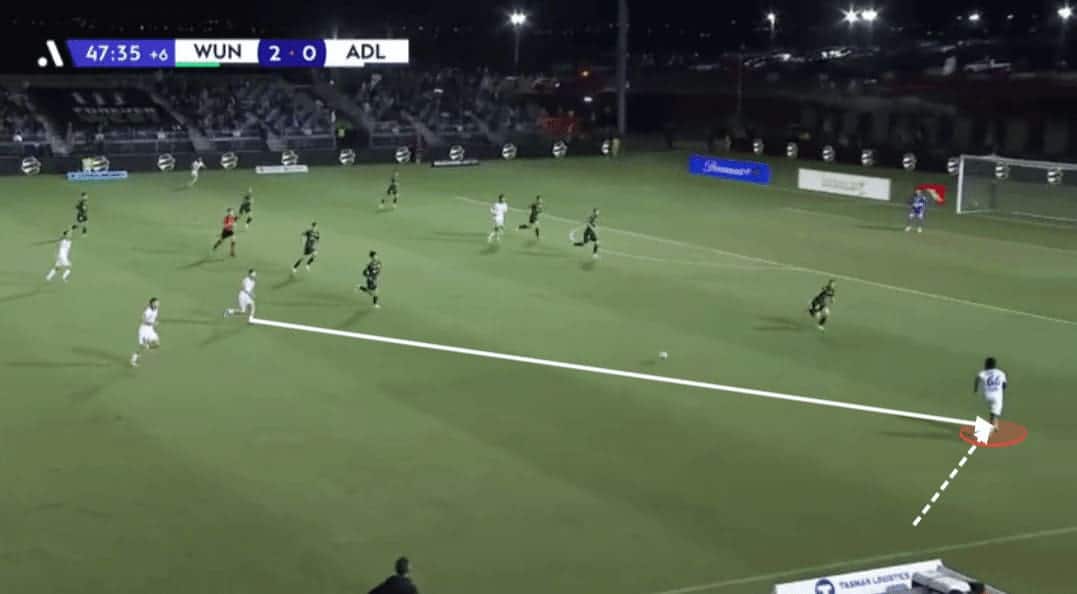
Here, the principle of overload to isolate is used to perfection. Irankunda is completely isolated on the right side and can receive the ball into his front foot.
His teammates are playing themselves out of the counterpress and scan the field for Irankunda, playing the switch towards him.
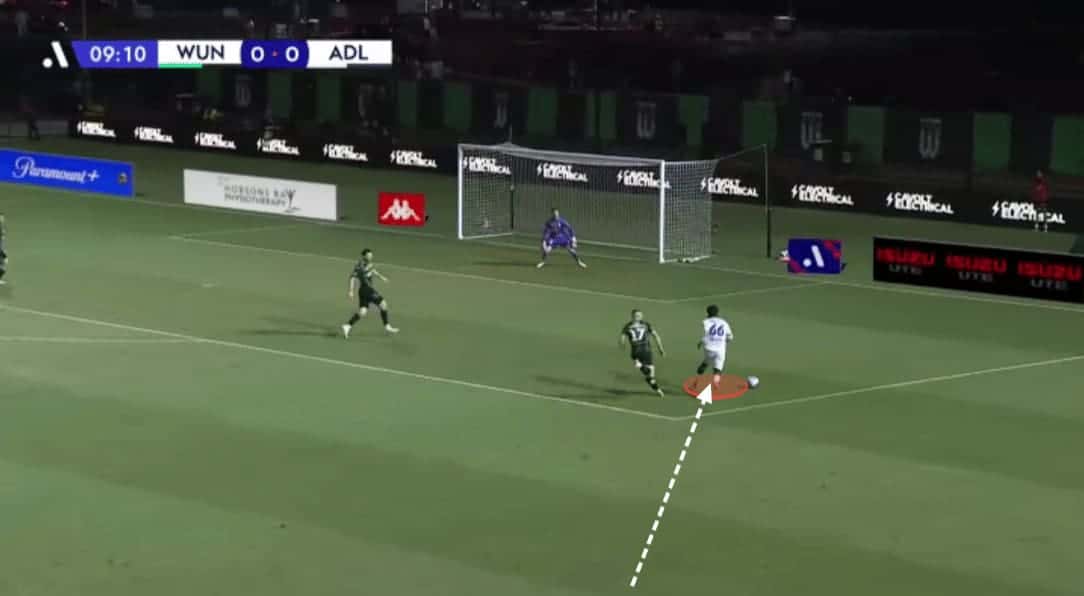
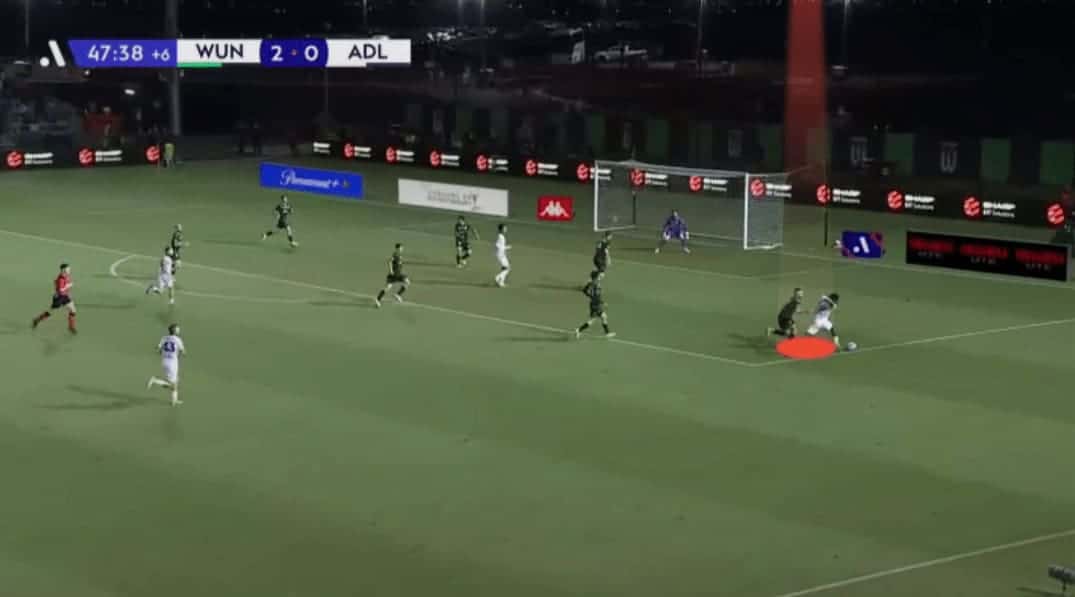
After receiving the ball, Irankunda isn’t wasting time and moves forward instantly, taking on the left back of the opposing team and breaking into the box quickly.
His cross in this situation was rather bad, but it was still a great counterattack by Adelaide United.
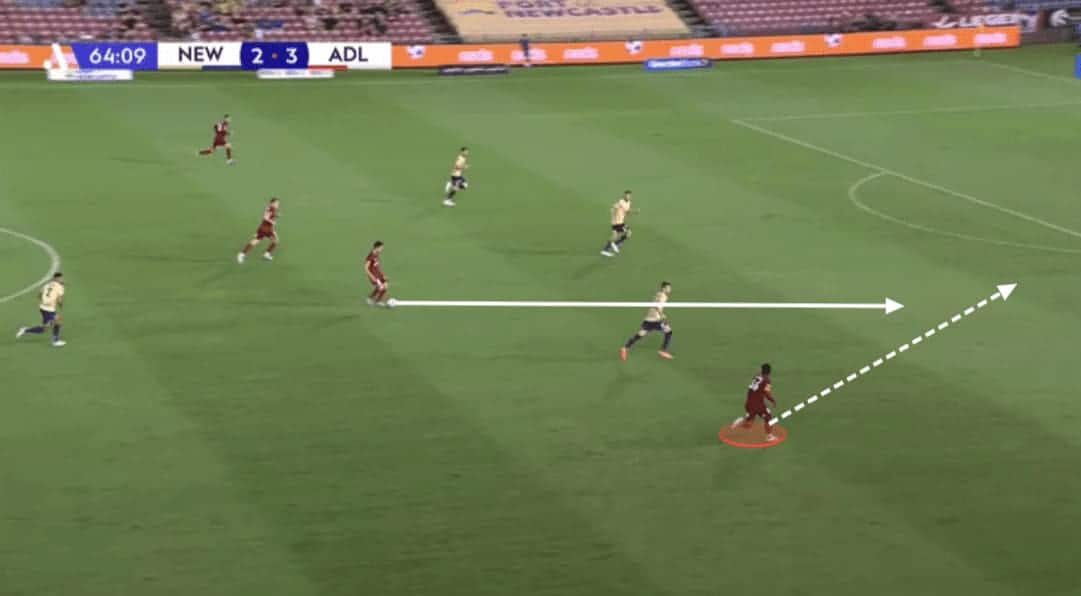
Here, Irankunda receives the ball of a switch on the counter once again. He was again holding a very wide position to get isolated on the right flank.
He uses his good first touch again to take on the left back instantly.
Once again, Adelaide was able to release Irankunda in a take-on on the right side of the field, where he could use his pace and dribbling to create a chance for United.
To sum things up, Irankunda is a great player in transition, being able to counterpress effectively and being a threat on the counter at all times.
Nestory Irankunda Strengths
After assessing the playing style of Nestory Irankunda throughout this scout report so far, it is now time to showcase the abilities that make him such an interesting prospect that a top club like FC Bayern was impressed enough to sign him to a long-term contract.
One of Irankunda’s biggest strengths is his drive towards goal and his shooting technique.
We already talked about how Irankunda forces take-ons after receiving the ball, but he is not just able to take on; his follow-up action is pretty much always a shot.
Usually, Irankunda threatens the defensive line with his brute pace. He is an incredibly fast player and, as stated before, can reach top speeds of over 37km/h.
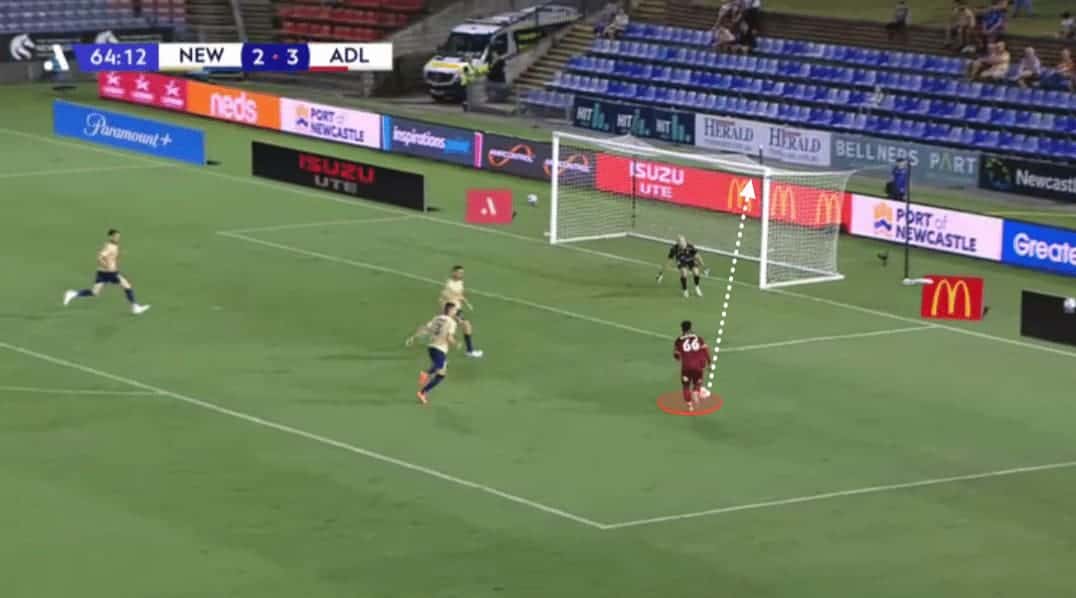
After receiving the ball, Irankunda uses only two touches.
With his first touch, he prepares the ball for the shot, and then he clinically finishes off the chance with a powerful shot into the top-right corner.
His shot power overall is really good, and it allows him to finish chances that are rather hard for other players to finish.
He is also threatening from outside the box. Irankunda’s shooting technique allows him to shoot from a distance as well, and he shoots very precisely and powerfully in these situations.
He also knows about this strength and always tries to put his defender in a position where he can easily get a shot off.
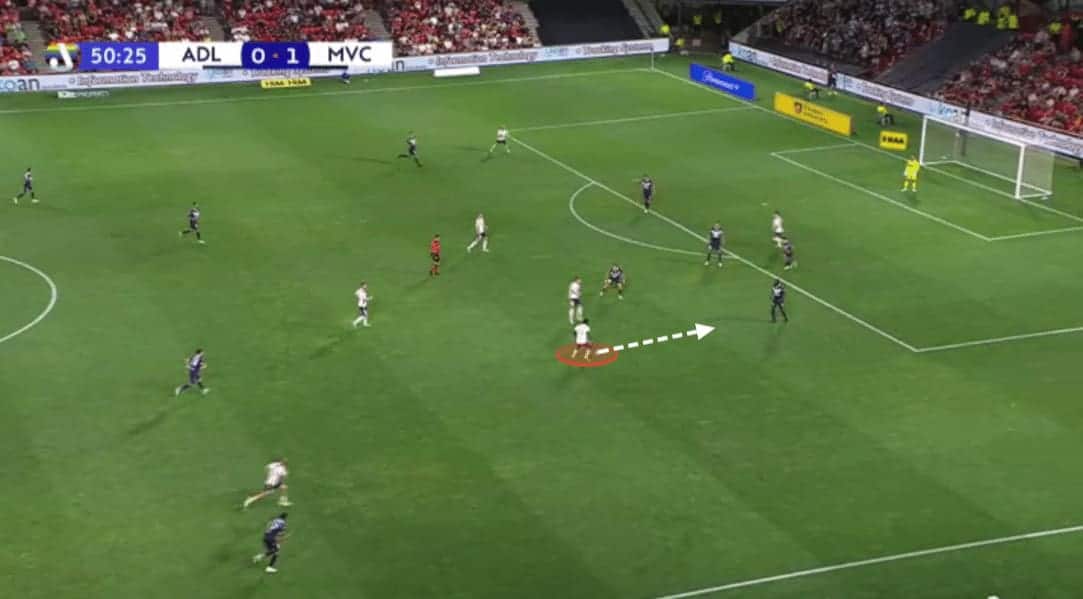
Here, Irankunda wins the second ball and is picked up by a defender quickly.
He uses his agility and pace to move onto his right foot and pulls the trigger as soon as the window opens up.
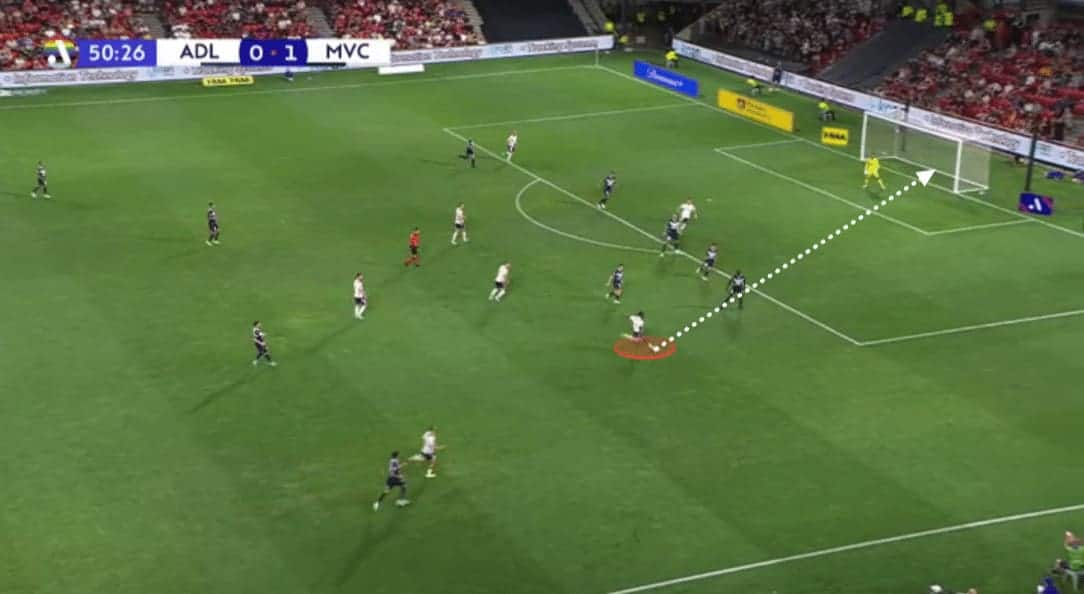
He opens up the window with his movement and is scoring a goal here.
In this situation, the keeper really helps out Irankunda and lets a saveable ball into his net.
His shooting technique is helpful in these situations, and Irankunda is also a threat at set pieces.
He is a good corner-taker, delivering balls into the box at a good height and speed.
Also, Irankunda can take direct free-kicks, scoring these at a decent rate with his nice shooting technique.
Overall, his biggest strength is his pace.
Combined with his great shooting technique, Irankunda is always a threat to score a goal from anywhere on the pitch and is a hard matchup for almost every defender he has faced.
Nestory Irankunda Weaknesses
Obviously, Nestory Irankunda has areas to improve in as well. In the end, he is just an 18-year-old player, even if he has made a lot of appearances in the A-League.
One of those areas is his crossing ability. As stated in the data profile, his success rate with his crosses is one of the worst in the league.
He still attempts a decent number of crosses but can not find his teammates to save his life.
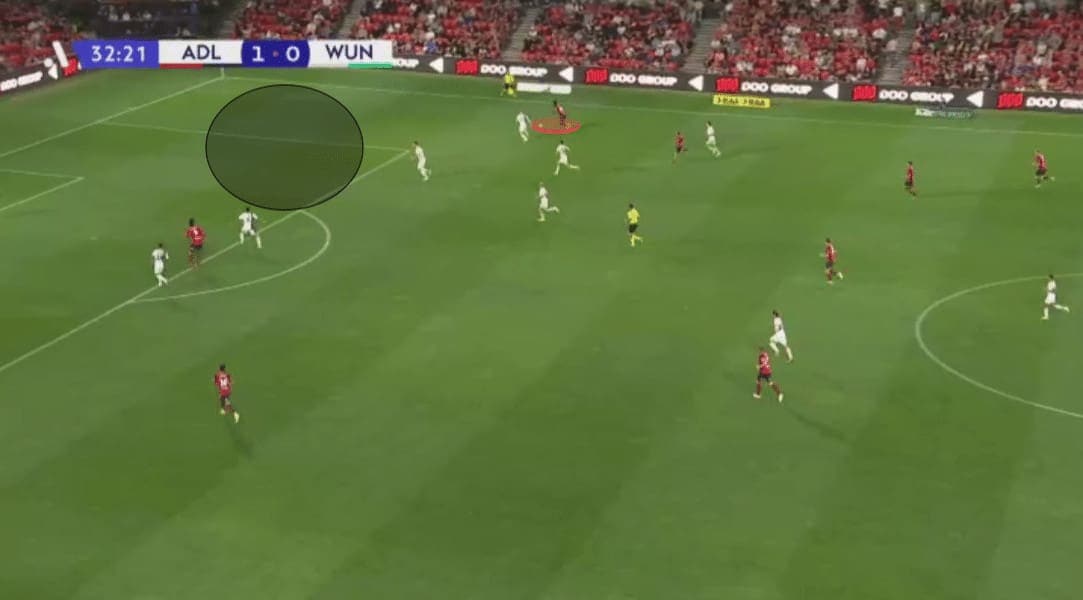
In this example, Irankunda crosses the ball in right away.
Usually, he would use his pace and dribbling to get past the last defender in his way and attack the marked space, but he refuses to do so here because the moment he decides to cross it, he is locked in on that option every single time.
Still, he does not put his head up and look towards the centre; he just puts the ball into the box, missing his teammate and allowing an easy claim for the opposing goalkeeper.
This just shows the problem with Irankunda’s’s crosses.
He rarely picks out a teammate to cross the ball to and just hits it as hard as he can towards the centre of the box.
This makes it really hard for his teammates to actually do something with the ball, and most of the time, he just overhits the crosses, and no one is able to claim it.
Irankunda prefers low crosses to high crosses simply because he lacks the technique to put some effect on the ball.
That means his high crosses are really predictable and easy for the defenders to clear away or even claim for the goalkeeper.
Irankunda usually has decent vision, so he should be able to improve his ability to find his teammates in the box.
However, his decision-making in these situations needs to improve significantly if he wants to succeed at FC Bayern.
Another problematic aspect of Irankunda is his left foot.
While his right foot is great, and he uses it to a good extent, his left foot leaves a lot to be desired.
He rarely uses his left foot, not just in terms of shooting and passing but also in terms of dribbling.
The vast majority of his touches are done by his right foot, making him predictable for the opposing defences and giving them a point of attack.
Irankunda gets by at the level of play he is facing right now, but against Bundesliga defenders, especially those of the top teams.
Irankunda will need to be multifaceted if he wants to succeed at the next level, and he definitely needs to be able to do basic things like passing with his left foot; otherwise, he won’t make the cut.
Conclusion
At just 18 years of age, Nestory Irankunda is an absolute standout in Australia and has shown flashes of great potential.
However, it needs to be addressed that the level of competition he has faced so far has been pretty low.
The jump from playing against A-League defenders to playing against Bundesliga defenders will not be easy for him.
Irankunda’s’s pace and athletic ability are great overall, and his demeanour on the pitch definitely shows that he can make another huge step in terms of development.
He will need to take that step in Germany if he wants to play for the first team at FC Bayern.
Overall, Irankunda is a pretty raw type of player with great instincts and a couple of very distinctive strengths (‘island talents’, as they’re called in Germany) — but he also lacks a lot of abilities a Bundesliga-level player needs to have.
His passing and crossing need to get better relatively quickly, especially.
Otherwise, he will be too easy to defend for more experienced players.
His left foot also needs a lot of work.
Obviously, some players have worked around that in the past, but Irankunda would still be smart to address it.
FC Bayern made an exciting signing in Irankunda, and now it will also be their responsibility to help the young Australian become the best version of himself.
For the first time in his career, Irankunda has access to elite training facilities and coaches, and they need to make use of them.
If they stay patient and help him through his first couple of months, we could see a future Alphonso Davies-like success story shaping up for FC Bayern and Nestory Irankunda.

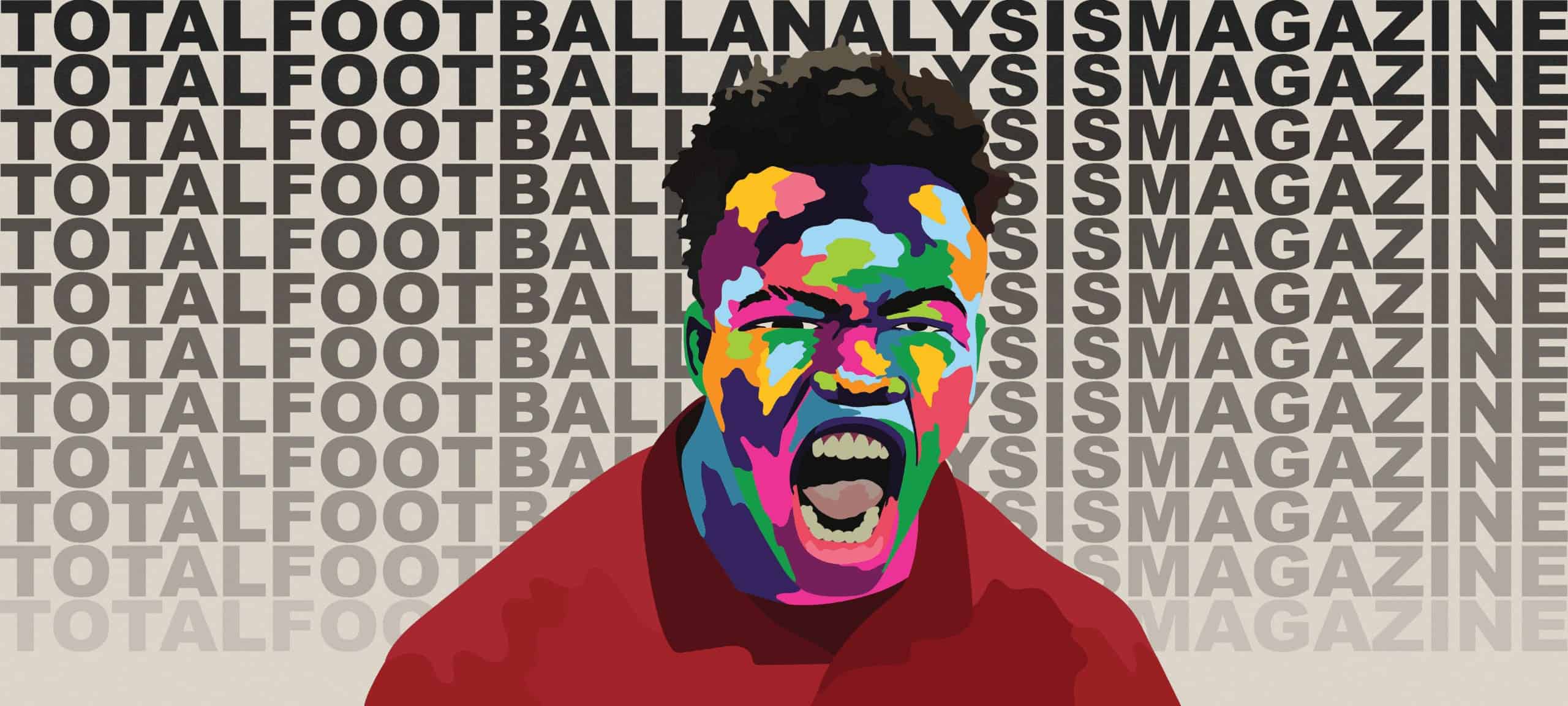




Comments